| |
|
St
Edmund, Norwich
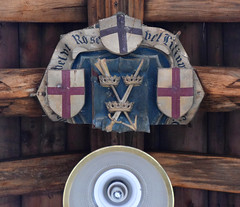 |
|
Today, Fishergate
is a quiet street on the outskirts of the city
centre, just to the west of Magdalen Street.
Standing outside St Edmund, it is hard to
conceive what the setting was like a century ago.
Where low-rise social housing and warehouses
spread was then the heartland of industrial
Norwich, enormous dark factories dwarfing this
little church. A small building with a
south aisle hidden from the street, the church
can never have had any of the grandeur of some of
its city neighbours. St Edmund is the patron
saint of East Anglia of course, and the
dedication suggests an Anglo-Saxon foundation,
but the church we see today has nothing about it
older than the 15th Century, when it was
completely rebuilt. However, the cottaged streets
and small workshops it once served were swept
away by the Industrial Revolution, which planted
the great shoe and hosiery factories in this
parish.
Inevitably, as its
parish population declined, St Edmund fell into
disuse before the end of the 19th Century, being
only a few hundred metres from St Martin at
Palace, St James and St Saviour. It quickly
decayed, the roof only being repaired to make it
watertight for use as a factory store.
|
Ironically,
the rest of the structure was in good condition, because
the church had been largely Victorianised not long before
the end of its liturgical life by the enthusiastic Edward
Boardman in the 1880s. Boardman's is the vestry with its
chimney, the roof and the top of the tower.
One night in January 1913,
Norwich was lit up by a massive fire when the factory
that surrounded the church on three sides went up in
flames. After that, the area became a wasteland, but some
attempt seems to have been made to rescue St Edmund. When
George Plunkett came this way in 1938 and took the three
photographs below, he found the building in fairly good
condition. The interior had been cleared except for some
benches facing inward, suggesting that it was in use as a
hall of some kind, perhaps for the nearby churches of St
James and St Saviour.
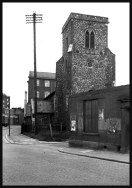 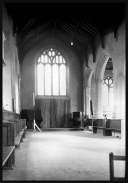 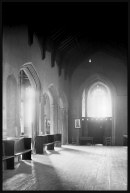
St Edmund
suffered damage in the War, and when Cautley visited in
1946 he was unable to get inside. For years after that,
the dereliction spiralled, until the church was little
more than a shell.
However, St Edmund is one of the few
churches that can be truly said to have benefited from
the Brooke Report of the late 1960s, which resulted in
large numbers of the Norwich city centre churches being
declared redundant and threatened with demolition. The
appalled reaction resulted in a renewed interest in
caring, and finding new uses, for Norwich's redundant
churches, and this led to its repair and renovation by
the Norfolk Churches Trust.
After a period of use as a store for the
nearby Norwich Puppet Theatre in St James, it was let to
Norwich Community Church, who rebadged it as the
Fishergate Centre. When they moved out to larger
premises, the lease was transferred to Norwich Pregnancy
Crisis for use as an advice and counselling centre,
keeping its new name. The interior was reordered
appropriately with stairways and partitions put in place
to make it suitable for its new use. Today, it is the
Fishergate House of Prayer, in the care of an ecumenical
organisation called Call To Prayer, part of the Ffald-y-Brenin Local Houses of
Prayer movement, who describe their mission as enabling,
encouraging and facilitating prayer.
The building is mindful of its heritage.
Before Boardman got its hands on it, St Edmund had a
perfectly serviceable Georgian interior, perhaps like a
small version of St George Colegate. Nothing at all
survives of either the Georgian or Victorian furnishings,
but this allows a clear view of an extraordinary arcade,
with open squint-like niches in between the arches. I
wonder what they were for?
The one great medieval survival of the
church is the remaining part of a boss, halfway along the
nave roof, which depicts the arms of St Edmund flanked by
those of St George and the cathedral priory. You can see
it at the top of this page. The lower part of the boss is
lost, but the upper part is surrounded by a repainted
banner which originally read Velut Rosa, Vel Lilium,
'like a rose or a lily'. The lost part of the inscription
would have declared that the church's patron saint was Flos
Martirum, 'flower of martyrs', the circular
inscription making sense in any order.
The aisle is organised
into quiet spaces, the continuous nave and chancel
leading to a large, simple wooden cross set on a raised
platform. The stairway and west gallery at the other end
are simple and do not intrude. All in all, it is a
lovely, prayerful space.
| St
Edmund is an adornment to its street and a useful
spiritual enterprise for the people of Norwich. If it is less well-known than many
of the Norwich medieval churches, this is largely
as a result of it being so hemmed in and cut off
from the city centre. However, in 2001, a view not seen in
more than a century was opened up when the
factory and warehouses to the south of the church
were demolished. They were quickly replaced by a
housing scheme, but not before Chris Harrison
snapped the view you see on the right. Take a
good look, because you won't see it like that
again in your lifetime.
|
|
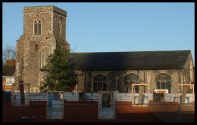 |
Simon Knott, January 2018
|
|
|
